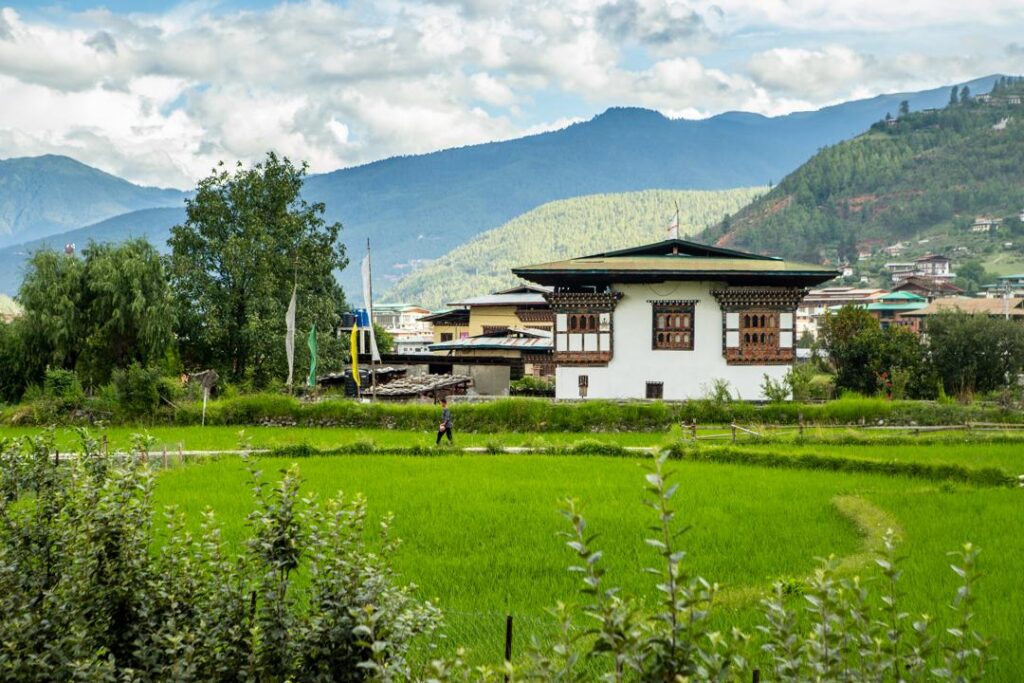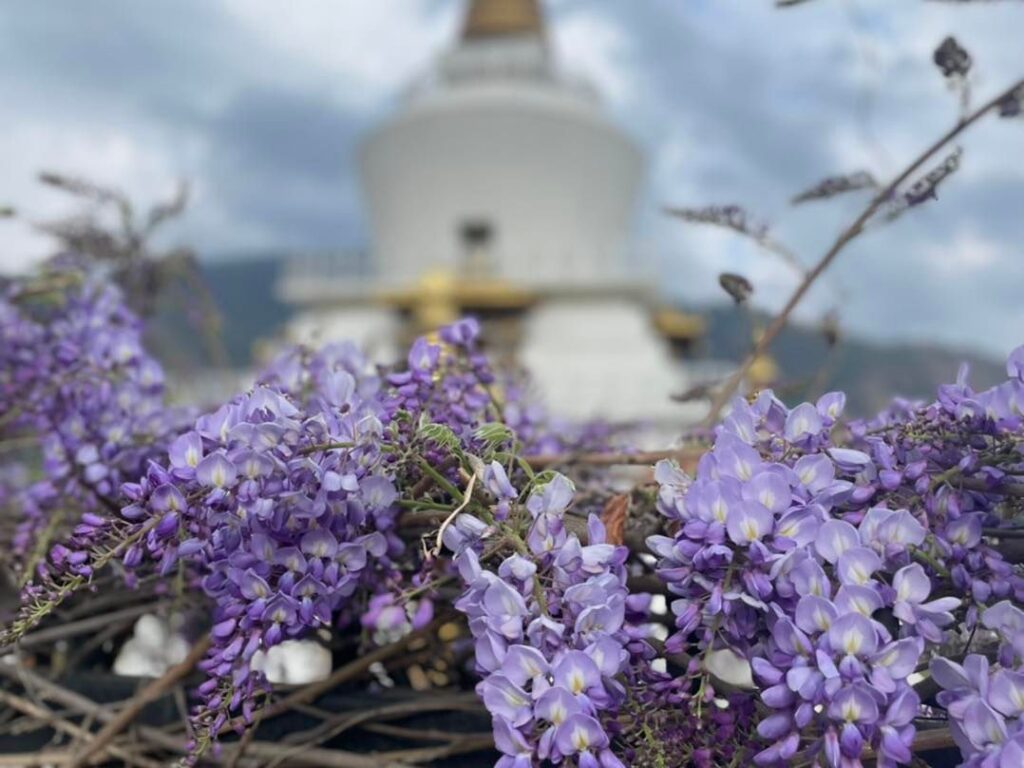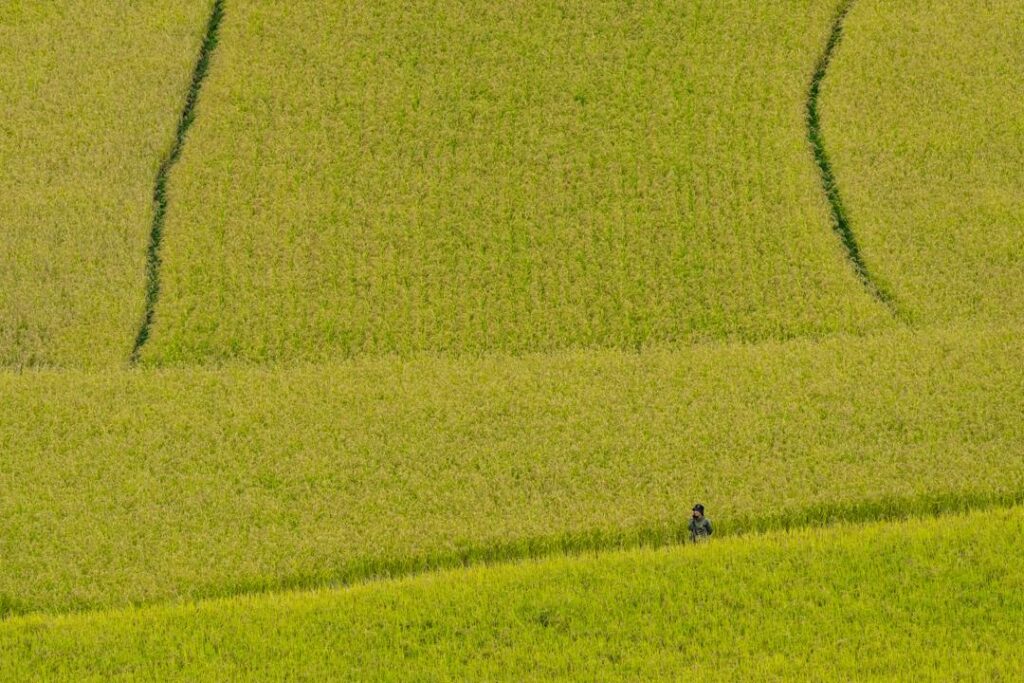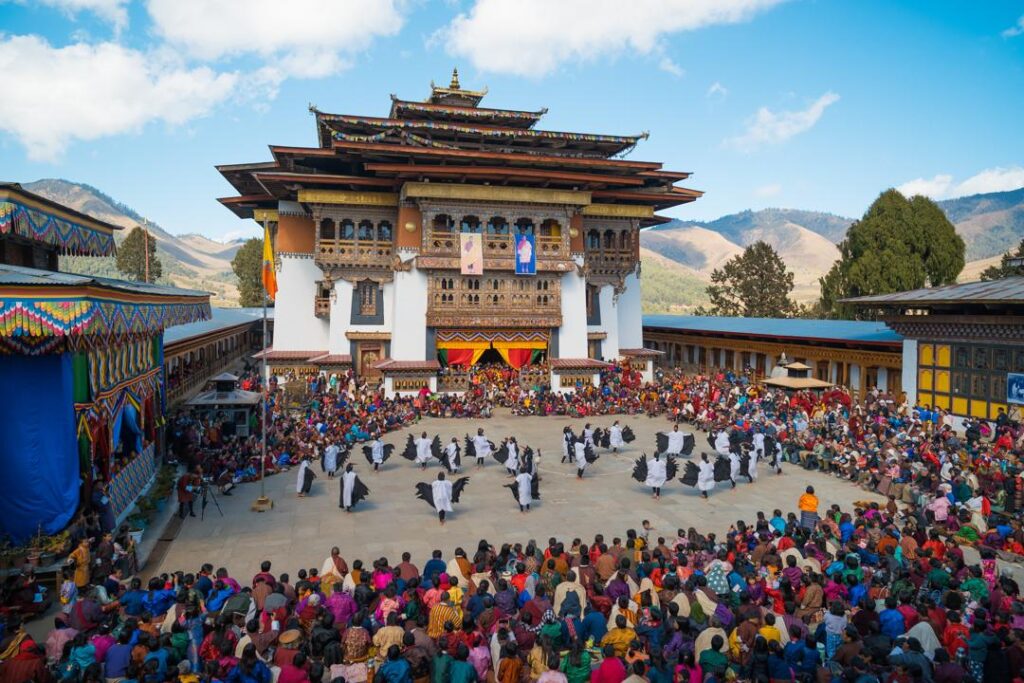Did you know Bhutan has four seasons, each with its own charm? It’s in the Eastern Himalayas, with landscapes that change a lot. This makes picking the best time to visit an exciting journey.
Spring in Bhutan is amazing, with cherry blossoms and rhododendrons turning valleys into a colorful wonderland. Autumn is great for trekking, with clear skies and stunning views. Winter brings snow, making the landscape peaceful and white. Summer is green, despite the rain.
Bhutan is perfect for cultural festivals, beautiful views, and real Himalayan adventures. Knowing the climate helps us enjoy Bhutan’s beauty and experiences fully.

Introduction to Bhutan’s Unique Climate
Bhutan is a place of stunning beauty, with a climate that’s just as special. It sits in the heart of the Himalayas, where its location shapes its weather. The climate here is a mix of tropical, temperate, and alpine zones, each with its own season.
As we explore Bhutan, we see how altitude and monsoons affect the weather. The high places get cold and snowy in winter, creating a winter wonderland. In the lower areas, the climate is warmer, making for a lively environment with each season bringing its own charm.
Spring is a time of change, with cherry blossoms and rhododendrons coloring the hills. The weather is mild, making it great for nature fans and hikers. This season is perfect for seeing Bhutan’s valleys and flowers in bloom.
Autumn is another great time to visit, with clear skies and beautiful views. It’s the best time for trekking, letting us enjoy the scenery without weather worries. Autumn’s weather in Bhutan is perfect for outdoor adventures and seeing the country’s beauty.
Winter adds a calm, snowy beauty to the high places, ideal for those seeking peace. The lower areas stay mild, making travel around Bhutan easy.
Knowing about Bhutan’s climate and weather helps plan a trip that fits your preferences. Each season in Bhutan offers something special, making every visit memorable.
Spring in Bhutan: A Blooming Wonderland
Spring in Bhutan is magical. The whole landscape changes color, and the weather is just right. It’s also the time for festivals that show off Bhutan’s traditions. Let’s explore what makes spring in Bhutan so special.
Cherry Blossoms and Rhododendrons
Cherry blossoms and rhododendrons bloom in the valleys. They turn the landscape into a colorful canvas. It’s a perfect time for nature lovers to explore and enjoy the beauty of Bhutan.

Mild and Pleasant Temperatures
The weather in spring is perfect for outdoor fun. It’s not too hot or cold, making it great for exploring. You can see the stunning views and enjoy the fresh mountain air.
Spring Festivals: Paro Tsechu
The Paro Tsechu festival is a highlight of spring. It’s filled with mask dances, cultural shows, and people from all over. It’s a chance to see Bhutan’s traditions up close. It’s a lively event that adds to the travel experience.
Spring in Bhutan is a true wonderland. With its beautiful blooms and cultural festivals, it’s a season for everyone. Whether you love nature or culture, spring in Bhutan is unforgettable.
Summer in Bhutan: Monsoon Magic
Summer in Bhutan brings a green paradise. The monsoon season turns the country into a lush wonderland. It’s a perfect time for nature lovers to explore.
Breathtaking Green Landscapes
The monsoon rains make Bhutan’s landscapes stunning. Valleys and mountains burst with greenery. Rivers and waterfalls grow, adding to the beauty.
For those who love nature, this season is a dream. It’s a time to connect with Bhutan’s natural wonders.
Travel Tips for Monsoon Season
Traveling in the monsoon has its challenges. But with the right gear, it can be rewarding. Pack waterproof clothes and sturdy shoes.
Don’t forget insect repellent to keep bugs away. With these tips, you can enjoy your trip without worries.
Festivals to Experience
Summer in Bhutan is filled with festivals. The Nimalung Festival and the Haa Summer Festival are highlights. They showcase Bhutan’s culture and traditions.
These festivals offer a unique look into Bhutanese life. They are must-see events during the monsoon season.
Weather, Travel Season for Bhutan
Planning your trip to Bhutan? Knowing the weather and seasons is key. This guide will help you pick the best time to visit, based on what you like to do.
Spring: Spring in Bhutan is a colorful dream. Cherry blossoms and rhododendrons bloom, painting the landscape. It’s great for photos and outdoor fun, with mild and pleasant weather.
Summer: Summer brings rain, turning Bhutan into a lush green paradise. It’s a unique experience, but travel might be a bit tricky. If you love nature and don’t mind getting wet, summer is for you.
Autumn: Autumn is perfect for trekking and seeing sights. The weather is cool, with clear skies and stunning Himalayan views. It’s also harvest time, with vibrant festivals and celebrations.
Winter: Winter in Bhutan is quiet and snowy, especially in the north. It’s ideal for those who prefer a calm trip. The mountains and valleys are breathtakingly beautiful.
Knowing Bhutan’s weather is crucial for a great trip. Whether you love spring’s blossoms, summer’s green, autumn’s clear skies, or winter’s snow, there’s a perfect time for you.
Autumn in Bhutan: Perfect for Trekking
Autumn in Bhutan paints the landscapes with vibrant colors. It’s a great time for trekkers to enjoy clear skies. The fall season offers stunning views, making it ideal for exploring Bhutan’s varied landscapes.
Crisp and Clear Skies
Autumn treks in Bhutan are known for their clear skies. The monsoon rains are over, making the air crisp and clear. This means trekkers can see the Himalayas in all their glory during the day and enjoy the stars at night.
The weather is also just right, not too hot or cold. This makes trekking comfortable and enjoyable.
Harvest Season Celebrations
Autumn is also a time for Bhutan’s harvest festivals. These festivals are a great way to dive into local culture. Events like Thimphu Tshechu show the spiritual and communal life of the Bhutanese.
With colorful dances, traditional music, and tasty harvest foods, these festivals enrich our trekking experience. They make our journey through Bhutan even more special.

Best Trekking Paths
Bhutan offers many great trekking paths in autumn. The Druk Path Trek and Jomolhari Trek are among the most popular. They showcase stunning natural beauty and cultural landmarks.
The Druk Path Trek is perfect for those looking for a moderately challenging trek. It features scenic lakes and ancient monasteries. On the other hand, the Jomolhari Trek is for more experienced adventurers. It offers high-altitude trails and breathtaking views of Jomolhari Mountain.
Each path in autumn offers a unique experience. They highlight Bhutan’s natural and cultural beauty.

Winter in Bhutan: Snow-Capped Serenity
Winter in Bhutan is a time of peace and beauty. The Himalayas turn into a magical winter wonderland. Snow covers the mountains, offering breathtaking views.
This season is perfect for those who love quiet and beauty. The villages in the mountains are especially beautiful. They have snow-covered roofs and a peaceful feel.
Winter in Bhutan is special. The snow-capped peaks and clear skies are stunning. The warm hospitality and traditional food add to the charm.
Winter in Bhutan is a unique experience. The snow-capped peaks and quiet villages make it unforgettable.
Best Time for Cultural Festivals in Bhutan
Planning a trip to Bhutan? Keep the festival season in mind to enhance your cultural experience. Bhutanese festivals, or Tsechus, are vibrant and deeply rooted in Bhutanese culture. They offer a glimpse into the country’s traditions and spirituality. Let’s look at the major cultural events in Bhutan and how the seasons affect these celebrations.
Major Festivals Throughout the Year
Bhutan is known for its festivals all year round. Key festivals include Paro Tsechu in spring, Thimphu Tsechu in autumn, and Punakha Drubchen in winter. These events feature colorful dances, intricate costumes, and religious rituals. They are a treat for the senses.
- Paro Tsechu: Held in early spring, Paro Tsechu celebrates the blooming of flowers, with cherry blossoms and rhododendrons adding to the beauty.
- Thimphu Tsechu: Celebrated in autumn, this festival takes place in clear, crisp weather, perfect for outdoor festivities.
- Punakha Drubchen: In winter, Punakha Drubchen is set against snow-capped mountains, creating a magical atmosphere.

Choosing Festivals Based on Weather
The timing of Bhutanese festivals is weather-dependent. Spring festivals like Paro Tsechu enjoy mild temperatures. Autumn festivals, such as Thimphu Tsechu, have clear skies and cool climates. Winter festivals, like Punakha Drubchen, offer a unique charm with snow and quiet surroundings.
To pick the best festival season, think about the weather and the events you want to see. Spring is great for those who love colorful blooms and mild weather. Autumn is perfect for clear, crisp days ideal for outdoor activities. Winter, with its snowy landscapes, provides a serene backdrop for intimate cultural events.
By planning your visit around these key cultural events, you can dive deep into Bhutanese culture. You’ll witness the joyous celebrations that define Bhutan’s spirit.
Outdoor Activities and Their Best Seasons
Exploring Bhutan’s adventures all year is exciting and unforgettable. The country’s climate changes with the seasons, offering many outdoor activities. Whether it’s trekking in spring or snow sports in winter, Bhutan has something special for everyone.
In spring, the scenery bursts with color as flowers bloom and the weather is mild. This is the perfect time for trekking. We get to see the amazing change in nature, with rhododendrons and cherry blossoms adding beauty to our paths.
Autumn brings clear skies and cool weather, ideal for hiking and cycling. It’s the best season for trekking, with breathtaking views along the way. The cool air makes exploring Bhutan’s landscapes even more enjoyable.
Winter turns Bhutan into a peaceful wonderland with a bit of snow. It’s a great time for unique adventures, like lower-altitude treks and cultural explorations. The snow-covered mountains create a stunning contrast to the lush greenery of other seasons.
Every season in Bhutan offers something special for outdoor lovers. Knowing the best times for our favorite activities can make our trip even more memorable. So, whether it’s spring, autumn, or winter, there’s always something exciting to do.
High and Low Seasons: Pros and Cons
Traveling to Bhutan has its ups and downs, depending on when you go. You’ll find different experiences in peak season and off-season. Costs, crowds, and weather all vary.
Peak season Bhutan falls in spring (March to May) and autumn (September to November). Spring offers clear skies and blooming landscapes, ideal for treks. Autumn brings crisp air and golden views. But, expect higher prices and more people.
Off-season travel in Bhutan, which includes summer and winter, has its perks. Prices are lower, making it more affordable. Summer’s rains make the country green and lush. Winter is calm, with snow and fewer tourists.
Choosing the right time for your Bhutan trip is key. You might prefer the green summer, snowy winter, or the vibrant spring and autumn. Your choice will make your trip unique.
Packing Tips for Bhutan’s Varying Weather
Traveling to Bhutan means being ready for different weather. It’s important to pack the right essentials for a great trip. Here’s what you should bring.
Essential Clothing and Gear
Knowing the weather is key to packing right. In spring, the blossoms and flowers call for light jackets and breathable clothes. Autumn’s cool air is perfect for hiking, so pack sturdy boots and warm layers for nights.
In winter, snow means you’ll need insulated jackets, thermal clothes, and gloves.
- Layered Clothing: Comfortable layers to adjust to the fluctuating temperatures.
- Sturdy Footwear: Reliable, waterproof hiking boots are necessary for trekking paths.
- Weather-Specific Gear: For spring and summer, breathable and moisture-wicking clothing; for autumn and winter, thermal layers and insulated gear.
Special Items for Seasonal Travel
Each season in Bhutan has its own beauty and needs. In the monsoon, a good rain jacket and waterproof bag are a must. For spring and autumn hikes, trekking poles help with balance.
Winter calls for warm snow boots and a thermal flask to keep drinks hot.
- Rain Gear: Essential for monsoon season, including a waterproof jacket and backpack cover.
- Trekking Poles: Useful for added stability on uneven terrain, particularly in autumn and spring.
- Thermal Accessories: Insulated gloves, hats, and a thermal flask are must-haves for winter travel.
By packing for each season, you’ll have a comfortable and memorable trip to Bhutan.